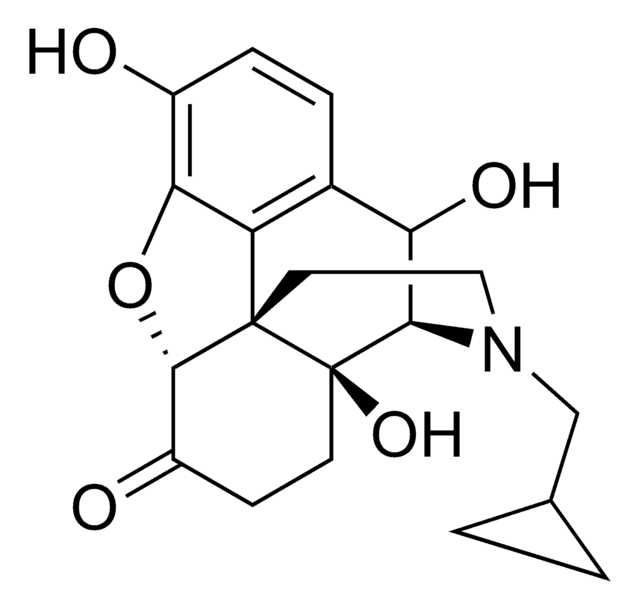Kluczowe dokumenty
About This Item
Polecane produkty
klasa czystości
analytical standard
Poziom jakości
gęstość pary
6.83 (vs air)
ciśnienie pary
1 mmHg ( 76.4 °C)
opis
olefine free
Próba
≥99% (GC)
temp. samozapłonu
455 °F
okres trwałości
limited shelf life, expiry date on the label
metody
HPLC: suitable
gas chromatography (GC): suitable
współczynnik refrakcji
n20/D 1.429 (lit.)
n20/D 1.429
bp
252-254 °C (lit.)
mp
5.5 °C (lit.)
gęstość
0.762 g/mL at 20 °C (lit.)
Zastosowanie
cleaning products
cosmetics
flavors and fragrances
food and beverages
personal care
Format
neat
ciąg SMILES
CCCCCCCCCCCCCC
InChI
1S/C14H30/c1-3-5-7-9-11-13-14-12-10-8-6-4-2/h3-14H2,1-2H3
Klucz InChI
BGHCVCJVXZWKCC-UHFFFAOYSA-N
Szukasz podobnych produktów? Odwiedź Przewodnik dotyczący porównywania produktów
Powiązane kategorie
Opis ogólny
Zastosowanie
- Determination of seven volatile organic compounds in the surgically resected colonic tissue samples of colorectal cancer patients by gas chromatography-mass spectrometry (GC-MS) following their extraction by headspace- and direct injection- based solid phase microextraction (SPME)
- Measurement of concentrations of volatile organic compounds (VOCs) in biogas samples obtained from three different biogas plants by gas chromatography-mass spectrometry
- Simultaneous identification and determination of volatile organic compounds (VOCs) and semi-volatile organic compounds (SVOCs) from air samples using a styrene-divinylbenzene polymer particle and activated carbon particles based sampling device and GC-MS
- Development and validation of a thermal desorption method coupled with gas chromatography-mass spectrometry (GC-MS) for the determination of VOCs in biogas samples after their collection into ™ inert film bags for sample treatment in multi-sorbent bed tubes
- Gas chromatography-mass spectrometry (GC-MS) method-based profiling of volatile organic compounds in the olive fruit headspace extracts
Inne uwagi
Informacje prawne
Hasło ostrzegawcze
Danger
Zwroty wskazujące rodzaj zagrożenia
Zwroty wskazujące środki ostrożności
Klasyfikacja zagrożeń
Asp. Tox. 1
Zagrożenia dodatkowe
Kod klasy składowania
10 - Combustible liquids
Klasa zagrożenia wodnego (WGK)
WGK 1
Temperatura zapłonu (°F)
215.6 °F - closed cup
Temperatura zapłonu (°C)
102 °C - closed cup
Środki ochrony indywidualnej
Eyeshields, Gloves
Wybierz jedną z najnowszych wersji:
Masz już ten produkt?
Dokumenty związane z niedawno zakupionymi produktami zostały zamieszczone w Bibliotece dokumentów.
Klienci oglądali również te produkty
Protokoły
Separation of Decane; Dodecane; Tetradecane; Hexadecane; Octadecane; Eicosane; Docosane; Tetracosane; Hexacosane; Octacosane
Separation of Hexane; Heptane; Octane; Nonane; Decane; Undecane; Dodecane; Tetradecane; Hexadecane; Octadecane; Eicosane; Tetracosane; Octacosane; Dotriacontane; Hexatriacontane; Tetracontane; Tetratetracontane
-3,7-dimetylo-2,6-oktadieno-1-ol; Neral; Geraniol; Geranial; Undecanal; Octan cytronellylu; Octan Nerylu; Octan 3,7-dimetylo-2,6-oktadienylu; 1-Tetradecen; Tetradekan; ?-Bisabolol
-3,7-Dimethyl-2,6-octadien-1-ol; Neral; Geraniol; Geranial; Undecanal; Citronellyl acetate; Neryl acetate; 3,7-Dimethyl-2,6-octadienyl acetate; 1-Tetradecene; Tetradecane; α-Bisabolol
Nasz zespół naukowców ma doświadczenie we wszystkich obszarach badań, w tym w naukach przyrodniczych, materiałoznawstwie, syntezie chemicznej, chromatografii, analityce i wielu innych dziedzinach.
Skontaktuj się z zespołem ds. pomocy technicznej









